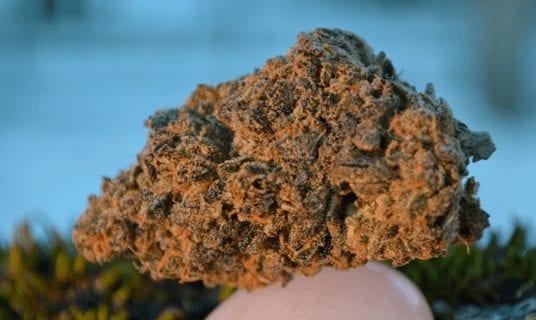
As you might expect, I seek out people committed to growing superior organic cannabis when acquiring samples for Pot Talk. Humboldt County-based cannabis farmer Jonathan Gilbert is one such person. I got the chance to interview him back in September after he took the grand prize at the 2nd Annual Golden Tarp Award, Humboldt County’s own light deprivation cannabis competition.
Gilbert is this talented, intelligent grower affiliated with Emerald Family Farms. He’s a totally amicable guy that’s into what he does. It’s not about profits or popularity with him, at least that’s my take. He’s all about increasing the quality of his cannabis through efficient, informed and adaptive technique.
I sought out Gilbert-grown cannabis for this edition because I know he’s got a lot of indoor growing experience. And he was kind enough to share some of his small batch Cherry Pie indoor with me on the spot. Thanks JG!
According to the cannabis information resource website Leafly.com, Cherry Pie is a cross of quintessential parent strains Granddaddy Purple and Durban Poison. It’s got a healthy internet trail — a bevy sites offer unique Cherry Pie reviews. Gilbert grew Cherry Pie at the request of a Bay Area dispensary owner who keeps the strain in his “stable.” He wanted to see what Gilbert could do with it. He did well…
The dense and chunky nugs of Cherry Pie have a midnight kind of vibe, an army to olive green color with a dark purple, almost black tinge. Tiny bright orange hairs contrast beautifully with the rich backdrop. If you break open a nug and look closely, you can see that the purple is not just a tinge to the nug. The small sugar leaves interspersed throughout the nug have extraordinarily detailed purple veins.
Also, the stems are remarkably thin with respect to the size of the nugs which are shaped like little fir cones, rotund at one end, tapering to a point at the other. They are the length of my thumb. And the buds are stable, not delicate or crumbly. Squeeze a nug and it’s sticky but not hard to break apart — perfect moisture content with snap.
Both the smell and flavor are complex — musky, citrusy, sweet but more sour. With respect to the smell in particular, I think it hits this borderline bitter lemon-and-leather high note. The lemon is tart and punchy, but the leather is comforting and nostalgic. And I found that the smell is different at different points in the nug. It’s a real expedition.
That citrus is a prominent factor in the flavor too, but it’s got a honey layer too it as well. It’s smooth and sophisticated, and I get hits of cardamom, coffee and fennel. Like Cherry Pie, it is absolutely delicious. But I think it tastes more like a dark spirit, such as brandy.
The high is a mellow and creative. It wasn’t intense, and I appreciate that. I did get the munchies and cotton mouth, but my heart didn’t race and my stomach didn’t drop. I smoked a bunch of it and was able to stay up past 9 p.m. — not wired or tired. That complex smell, appearance and flavor translates into a balanced and even keeled high.
 Gilbert grew this Cherry Pie indoors in individual pots with organic soil. Each pot was given specialized attention, hand watered. Soil is of central importance to plant health, and Gilbert’s take on cannabis farming is cutting edge in this regard. Gilbert versed on the chemistry and biology of soil science, and he is quick to talk in terms of beneficial bacteria, nematodes, mycorrhizal fungi, enzymes, polypeptide chains, chelation, interactions at the molecular level… It’s like he’s not afraid to help other cannabis folks start to think in these terms.
Gilbert grew this Cherry Pie indoors in individual pots with organic soil. Each pot was given specialized attention, hand watered. Soil is of central importance to plant health, and Gilbert’s take on cannabis farming is cutting edge in this regard. Gilbert versed on the chemistry and biology of soil science, and he is quick to talk in terms of beneficial bacteria, nematodes, mycorrhizal fungi, enzymes, polypeptide chains, chelation, interactions at the molecular level… It’s like he’s not afraid to help other cannabis folks start to think in these terms.
Like his linguistics, his soil is not bland or watered-down; he utilizes solid and liquid amendments with the fundamental consideration that soil is a complex ecosystem in itself, and keeping the soil healthy will enable him to optimize plant health. As for lighting, he used light rail technology with two 1000 watt fixtures. He says he saved an enormous amount of energy with this configuration, and the yield was the same quality as he normally produces.
The plants were short and stocky, and he says they were prone to growing herm clusters toward the bottom. So he brought the plants up, manicured them from the bottom upward which eliminated the herm cluster issue. Perfectly formed flowers remained. The color of the plants was a dark military green color till around week five when they transitioned into a dark purple. He cured it conscientiously, avoided drying it quickly and aggressively.
And his conscientiousness comes through. This Cherry Pie is handsome, guilt-free organic indoor with explosive flavors and a therapeutic effect.
Written by Emily Hobelmann



Leave a Reply